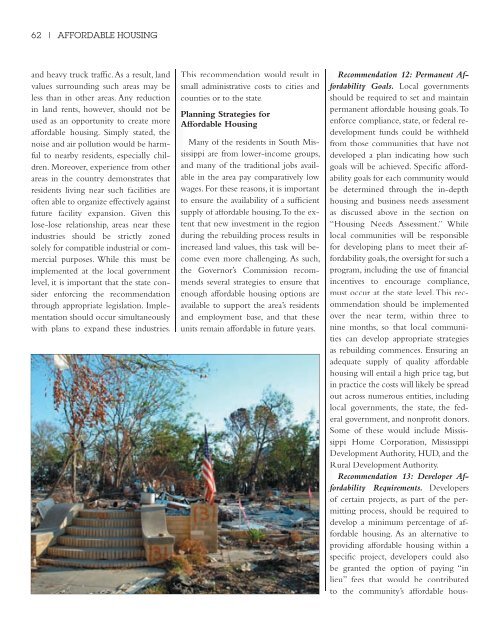62 | AFFORDABLE HOUSINGand heavy truck traffic. As a result, landvalues surrounding such areas may beless than in other areas. Any reductionin land rents, however, should not beused as an opportunity to create moreaffordable housing. Simply stated, thenoise and air pollution would be harmfulto nearby residents, especially children.Moreover, experience from otherareas in the country demonstrates thatresidents living near such facilities areoften able to organize effectively againstfuture facility expansion. Given thislose-lose relationship, areas near theseindustries should be strictly zonedsolely for compatible industrial or commercialpurposes. While this must beimplemented at the local governmentlevel, it is important that the state considerenforcing the recommendationthrough appropriate legislation. Implementationshould occur simultaneouslywith plans to expand these industries.This recommendation would result insmall administrative costs to cities andcounties or to the state.Planning Strategies forAffordable HousingMany of the residents in South Mis-sissippi are from lower-income groups,and many of the traditional jobs availablein the area pay comparatively lowwages. For these reasons, it is importantto ensure the availability of a sufficientsupply of affordable housing. To the extentthat new investment in the regionduring the rebuilding process results inincreased land values, this task will becomeeven more challenging. As such,the Governor’s Commission recommendsseveral strategies to ensure thatenough affordable housing options areavailable to support the area’s residentsand employment base, and that theseunits remain affordable in future years.Recommendation 12: Permanent Af-fordability Goals.Local governmentsshould be required to set and maintainpermanent affordable housing goals. Toenforce compliance, state, or federal redevelopmentfunds could be withheldfrom those communities that have notdeveloped a plan indicating how suchgoals will be achieved. Specific affordabilitygoals for each community wouldbe determined through the in-depthhousing and business needs assessmentas discussed above in the section on“Housing Needs Assessment.” Whilelocal communities will be responsiblefor developing plans to meet their affordabilitygoals, the oversight for such aprogram, including the use of financialincentives to encourage compliance,must occur at the state level. This recommendationshould be implementedover the near term, within three tonine months, so that local communitiescan develop appropriate strategiesas rebuilding commences. Ensuring anadequate supply of quality affordablehousing will entail a high price tag, butin practice the costs will likely be spreadout across numerous entities, includinglocal governments, the state, the federalgovernment, and nonprofit donors.Some of these would include <strong>Mississippi</strong>Home Corporation, <strong>Mississippi</strong>Development Authority, HUD, and theRural Development Authority.Recommendation 13: Developer Af-fordability Requirements.Developersof certain projects, as part of the permittingprocess, should be required todevelop a minimum percentage of affordablehousing. As an alternative toproviding affordable housing within aspecific project, developers could alsobe granted the option of paying “inlieu” fees that would be contributedto the community’s affordable hous-
THE GOVERNOR’S COMMISSION REPORT | 63ing fund, which may be channeled into“Community Land Trusts” as describedbelow. This approach would be adoptedon a community-by-community basis,as part of a local government’s plan formeeting the permanent affordabilitygoals and, where adopted, should beimplemented relatively early on, perhapsbetween six and nine months, sothat it may be applied as developers beginthe rebuilding process. This recommendationcarries a relatively high pricetag that will be imposed primarily upondevelopers. Ultimately, however, developerswill pass the price increase alongto the purchasers of non-affordablehousing within their developments.Recommendation 14: Developer AffordabilityIncentives. In place of, or inaddition to, affordability requirementsfor developers, cities and counties cancreate incentives to encourage developersto incorporate a greater percentageof affordable housing within their projects,as well as to make their housingunits safer and more efficient. Theseincentives could take the form of densitybonuses that allows higher densitiesthan would normally be allowed withinthe zoning requirements, expeditedpermitting, waived or reduced offstreetparking requirements, or otherincentives backed by financial mechanisms.Each community must assess itscapacity for incentives, although somenonprofit organizations, such as GlobalGreen, Smart Growth America, or theUrban Land Institute, may provide suggestionson the type of incentives thathave proved effective in the past. Thesewill be less controversial than affordabilityrequirements for developers, and,therefore, can be implemented morerapidly – ideally within three to sixmonths. This will encourage the developmentof more affordable housing asthe rebuilding process begins. Some ofthe incentives – such as reduced permittingfees – may result in a small reductionin local government revenues.Over the longer term, however, muchof this reduction may be offset by lowerinfrastructure requirements associatedwith dense, mixed-use developmentpatterns.Financial MechanismsIn addition to the institutional recommendationsdescribed above, thereare a number of financial mechanismsthat could be used to encourage an adequatesupply of affordable housing asthe Coast reconstructs and grows. Thesesuggestions can be organized into threebroad categories: providing immediatefinancial relief for communities to allowtime for adequate planning for affordablehousing; increasing the opportunitiesfor affordable home ownership, andincreasing the quality and efficiency ofaffordable housing.With displaced residents, businessesstruggling to reopen with a shortageof labor, and decimated municipal andcounty tax bases, the pressures to rebuildhousing as quickly as possible are enormous.Even so, it is important to ensurethat adequate time is allowed for strategicplanning such that that the timeand money invested in the rebuildingprocess yields optimal returns. It is useful,therefore, to consider strategies thatcan relieve, at least to some extent, thepressure to rebuild at break-neck speed.Recommendation 15: Municipal Tax-Base Relief. Municipal and county budgetsare highly dependent on propertytaxes, which have been dramatically reducedfollowing the destruction of Katrina.For this reason, local governmentsare pressured to have owners rebuildas quickly as possible – even beforethe planning process is complete – sothey may begin paying property taxes.To circumvent this dilemma, it wouldbe useful to allocate some federal andstate funding, likely through appropriations,to pay a portion of the lost propertytaxes within these communities for2006 and 2007. This would allow thecommunities to continue to provideservices and maintain employees withouthaving to “rush to rebuild” beforethey are ready and before planning isadequate. Congress, federal agenciessuch as HUD or FEMA, state government,or some combination thereofshould fund this relief. The fundingstream for this recommendation shouldbe established as quickly as possible, ideallywithin three months. The requiredsubsidy to local governments graduallywill diminish over a period of one totwo years as housing is rebuilt and localtax-base revenues stabilize. The exactcosts for such a program have notbeen tabulated, but they are certainto be large. For this reason, federal involvementwill likely be necessary, butstate resources, if available, will certainlyprove useful as well.AffordabilityThe Commission recommends thatthat all housing initiatives related toHurricane Katrina place a priority onaddressing the needs of low-income/low-wealth residents by directing significantresources to those census tractsdesignated by the United States TreasuryDepartment as “Investment Areas.”The Treasury Department’s CommunityDevelopment Financial InstitutionsFund (CDFI Fund) requires that recipientsof certain federal funds designatea target market. All target markets mustinclude “Investment Areas” to be competitivein the application. CDFI Fund




